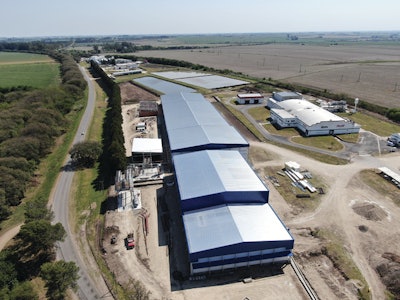
By March 2022, Argentinian poultry producer Grupo Motta should have its new poultry processing plant, Calisa 2, up and running. Built on a greenfield site in General Racedo, Entre Rios, the new facility will not only see the company’s capacity dramatically increase but offer a new source of employment and bring with it a new forest of 26,000 trees.
In March 2018, the construction of Calisa 2 began with an investment of US$22 million, guaranteeing an increase in slaughter capacity from 2 million birds per month to 8 million over a 10 years process. The plant forms a core part of Motta’s plans to raise production and increase overseas sales.
Various factors led the company to opt for building a completely new facility rather than extending its current plant.
Calisa CEO, Augusto Motta, explains: “There were two reasons for building a whole new greenfield plant as opposed to expanding our existing one.
“Firstly, to produce more. We no longer had any more options to grow or to offer a wider range of products. Secondly, given our export ambitions, to separate the processing of broilers and layers, we currently process together.”
Once Calisa 2 is functioning it will handle all of the company’s broiler processing. Calisa 1 will be dedicated soley to the processing of layers.
Like much else in the world, the construction of Calisa 2 has not been unaffected by COVID-19 disruptions. For example, suppliers have had difficulties in sourcing some materials, however, the company recognizes the efforts that its suppliers have made to keep the project moving. The new forest, however, is now fully planted, ready to play its part in reducing the plant’s carbon footprint once operational.
Calisa 2, which has a covered area of 13,000 m2 over a 26,000 m2 site, will initially operate at 60% of its slaughter capacity. This will be increased as the company grows the number of farms that it works with, raises feed production, and achieves greater market penetration. The plant will eventually employ 115 workers with production output that rises from 106 to 326 metric tons per employee per year.
Flexible design
The average bird size processed at the new plant will be 3 kg, with an estimated output of 15,000 2.8 kg birds per hour and 4,000 4 kg birds per hour.
The plant will not only see the company raise its output but will allow it to alter its product mix as needed. Currently, Grupo Motta’s production comprises 70% while birds and 30% parts, however, Calisa 2 will allow the company to increase its focus on parts.
Fifty percent of output at the new site will initially be cut-ups but the facility has been designed in such a way that it can be used exclusively for cuts, which is the company’s long term goal.
Calisa 2 will benefit from the latest state of the art technology and the company is working with Marel for the supply of the whole processing line from primary processing through to batching and packing.
Logical progression
Grupo Motta has a good history of expansion to continue building. Its beginnings date back to 1958 to Feller, a poultry farm with now more than 60 years incubating Hy-line international genetics and with more than 55% of the Argentine market share.
In 2000, production began at the Calisa plant to consolidate all its production units - 100% of the poultry value chain. Today, Calisa maintains a commercial policy with 50% of the production sold in the most demanding international markets of Latin America, Asia and Europe. The company recently entered Canada, the first Argentine poultry company to do so.
Calisa already supplies a number of supermarket and quick service restaurant chains, including Stephan DuCharme’s Dia Supermarkets, Burger King, Mostaza and Subway, but has its sites trained on seeing its own packaging and branding appearing on more supermarket shelves around the world.
Strategic partners
Grupo Motta currently sources its birds from three company-owned farms and 47 integrators, but these numbers will grow along with Calisa 2. Farms are located in low disease pressure areas and at an average distance of 50 km from the company’s central offices, hatchery, feed and slaughter and processing plants.
Integrated farmers are considered “strategic partners”, and are supported in a variety of ways from financial support through to health and technical training.
Environmental responsibility
In parallel with Calisa 2, the company has completed a major tree planting project. Located at approximately 2.5 km from Calisa 2, this new forest will be used to treat the effluent produced by the plant. With 4,500 meters of pipes and 77.5 km of ditches, the plant’s effluent will be sent the 32 hectares forest which is home of 26,656 trees.
Once the Calisa 2 plant is functioning, the establishment's water consumption will amount to 820,000 m3 / year, which will be balanced with the needs of forestry, avoiding discharge into the natural water course.
The forest, however, not only reuses the effluent of the processing plant it will also act as an air purifier. The trees will produce enough oxygen for a population of 6,400 people.
The new facility looks set to take Motta to the next level in production. With a Presidential visit already under its belt, the future looks positive for the new plant.

Significant tree planting will allow the new site to have a positive carbon footprint. | Grupo Motta


















